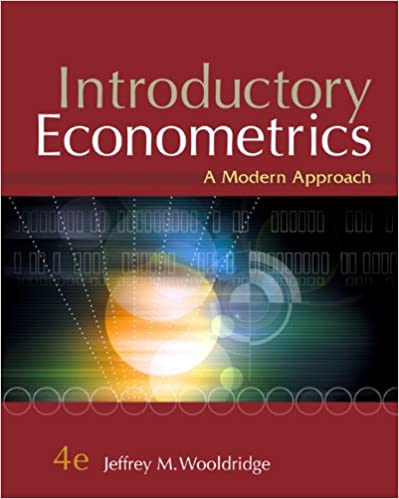
Introductory Econometrics 4th Edition by Jeffrey Wooldridge
Edition 4ISBN: 978-0324660609
Introductory Econometrics 4th Edition by Jeffrey Wooldridge
Edition 4ISBN: 978-0324660609 Exercise 10
11 Okun's Law-for example, Mankiw (1994, Chapter 2)-implies the following relationship between the annual percentage change in real GDP, pcrgdp, and the change in the annual unemployment rate, unem:
pcrgdp = 3 - 2 unem.
If the unemployment rate is stable, real GDP grows at 3% annually. For each percentage point increase in the unemployment rate, real GDP grows by two percentage
points less. (This should not be interpreted in any causal sense; it is more like a statistical description.)
To see if the data on the U.S. economy support Okun's Law, we specify a model that allows deviations via an error term, pcrgdp t = 0 + 1 unem t + u t.
(i) Use the data in OKUN.RAW to estimate the equation. Do you get exactly 3 for the intercept and 2 for the slope Did you expect to
(ii) Find the t statistic for testing H0: 1 = 2. Do you reject H0 against the two-sided alternative at any reasonable significance level
(iii) Find the t statistic for testing H0: 0 = 3. Do you reject H 0 at the 5% level against he two-sided alternative Is it a "strong" rejection
(iv) Find the F statistic and p-value for testing H 0 : 0 = 3, 1 = 2 against the alternative that H 0 is false. Overall, would you say the data reject or tend to support
Okun's law
pcrgdp = 3 - 2 unem.
If the unemployment rate is stable, real GDP grows at 3% annually. For each percentage point increase in the unemployment rate, real GDP grows by two percentage
points less. (This should not be interpreted in any causal sense; it is more like a statistical description.)
To see if the data on the U.S. economy support Okun's Law, we specify a model that allows deviations via an error term, pcrgdp t = 0 + 1 unem t + u t.
(i) Use the data in OKUN.RAW to estimate the equation. Do you get exactly 3 for the intercept and 2 for the slope Did you expect to
(ii) Find the t statistic for testing H0: 1 = 2. Do you reject H0 against the two-sided alternative at any reasonable significance level
(iii) Find the t statistic for testing H0: 0 = 3. Do you reject H 0 at the 5% level against he two-sided alternative Is it a "strong" rejection
(iv) Find the F statistic and p-value for testing H 0 : 0 = 3, 1 = 2 against the alternative that H 0 is false. Overall, would you say the data reject or tend to support
Okun's law
Explanation
Consider is the annual percentage chang...
Introductory Econometrics 4th Edition by Jeffrey Wooldridge
Why don’t you like this exercise?
Other Minimum 8 character and maximum 255 character
Character 255


